The NVIDIA GeForce GTX 980 Ti Review
by Ryan Smith on May 31, 2015 6:00 PM ESTPower, Temperature, & Noise
As always, last but not least is our look at power, temperature, and noise. Next to price and performance of course, these are some of the most important aspects of a GPU, due in large part to the impact of noise. All things considered, a loud card is undesirable unless there’s a sufficiently good reason – or sufficiently good performance – to ignore the noise.
As the GM200 flagship card, GTX Titan X gets the pick of the litter as far as GM200 GPUs go. GTX Titan X needed fully-functional GM200 GPUs, and even then needed GPUs that were good enough to meet NVIDIA’s power requirements. GTX 980 Ti on the other hand, as a cut-down/salvage card, gets second pick. So we expect to see these chips be just a bit worse; to have either functional units that came out of the fab damaged, or have functional units that have been turned off due to power reasons.
| GeForce GTX Titan X/980 Voltages | ||||
| GTX Titan X Boost Voltage | GTX 980 Ti Boost Voltage | GTX 980 Boost Voltage | ||
| 1.162v | 1.187v | 1.225v | ||
Looking at voltages, we can see just that in our samples. GTX 980 Ti has a slightly higher boost voltage – 1.187v – than our GTX Titan X. NVIDIA sometimes bins their second-tier cards for lower voltage, but this isn’t something we’re seeing here. Nor is there necessarily a need to bin in such a manner since the 250W TDP is unchanged from GTX Titan X.
| GeForce GTX 980 Ti Average Clockspeeds | |||
| Game | GTX 980 Ti | GTX Titan X | |
| Max Boost Clock | 1202MHz | 1215MHz | |
| Battlefield 4 |
1139MHz
|
1088MHz
|
|
| Crysis 3 |
1177MHz
|
1113MHz
|
|
| Mordor |
1151MHz
|
1126MHz
|
|
| Civilization: BE |
1101MHz
|
1088MHz
|
|
| Dragon Age |
1189MHz
|
1189MHz
|
|
| Talos Principle |
1177MHz
|
1126MHz
|
|
| Far Cry 4 |
1139MHz
|
1101MHz
|
|
| Total War: Attila |
1139MHz
|
1088MHz
|
|
| GRID Autosport |
1164MHz
|
1151MHz
|
|
| Grand Theft Auto V |
1189MHz
|
1189MHz
|
|
The far more interesting story here is GTX 980 Ti’s clockspeeds. As we have pointed out time and time again, GTX 980 Ti’s gaming performance trails GTX Titan X by just a few percent, this despite the fact that GTX 980 Ti is down by 2 SMMs and is clocked identically. On paper there is a 9% performance difference that in the real world we’re not seeing. So what’s going on?
The answer to that is that what GTX 980 Ti lacks in SMMs it’s making up in clockspeeds. The card’s average clockspeeds are frequently two or more bins ahead of GTX Titan X, topping out at a 64MHz advantage under Crysis 3. All of this comes despite the fact that GTX 980 Ti has a lower maximum boost clock than GTX Titan X, topping out one bin lower at 1202MHz to GTX Titan X’s 1215MHz.
Ultimately the higher clockspeeds are a result of the increased power and thermal headroom the GTX 980 Ti picks up from halving the number of VRAM chips along with disabling two SMMs. With those components no longer consuming power or generating heat, and yet the TDP staying at 250W, GTX 980 Ti can spend its power savings to boost just a bit higher. This in turn compresses the performance gap between the two cards (despite what the specs say), which coupled with the fact that performance doesn't scale lineraly with SMM count or clockspeed (you rarely lose the full theoretical performance amount when shedding frequency or functional units) leads to the GTX 980 Ti trailing the GTX Titan X by an average of just 3%.
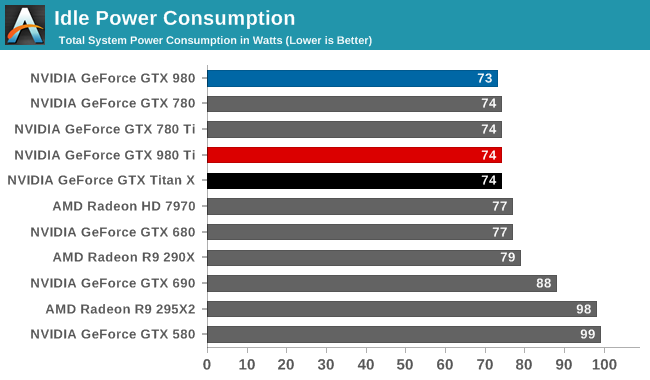
Starting off with idle power consumption, there's nothing new to report here. GTX 980 Ti performs just like the GTX Titan X, which at 74W is second only to the GTX 980 by a single watt.
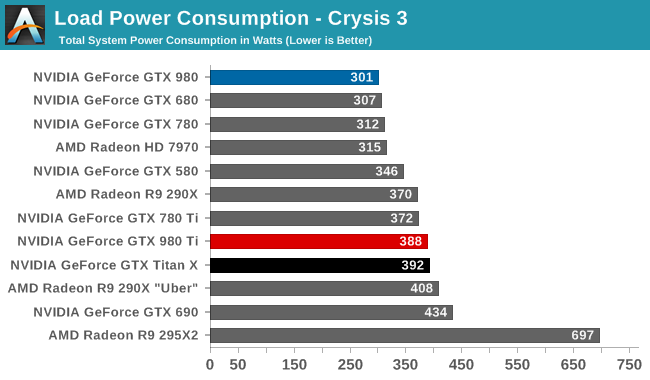
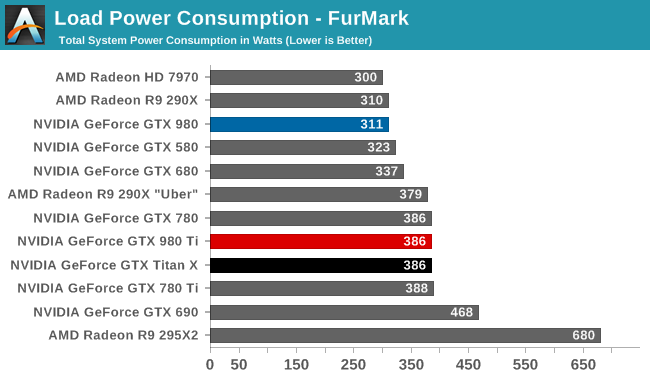
Meanwhile load power consumption is also practically identical to the GTX Titan X. With the same GPU on the same board operating at the same TDP, GTX 980 Ti ends up right where we expect it, next to GTX Titan X. GTX Titan X did very well as far as energy efficiency is concerned – setting a new bar for 250W cards – and GTX 980 Ti in turn does just as well.
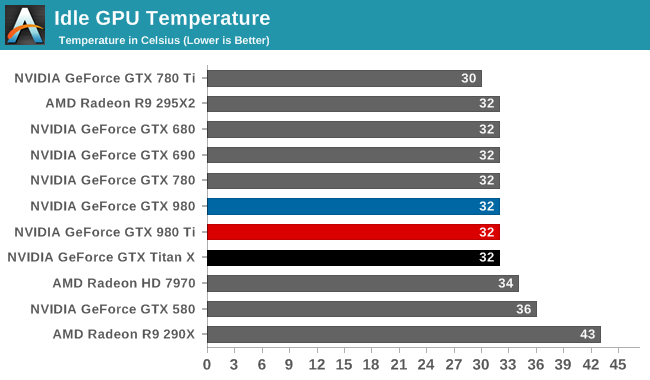
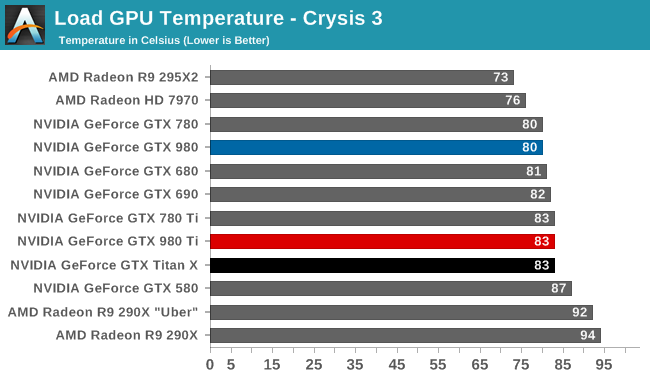
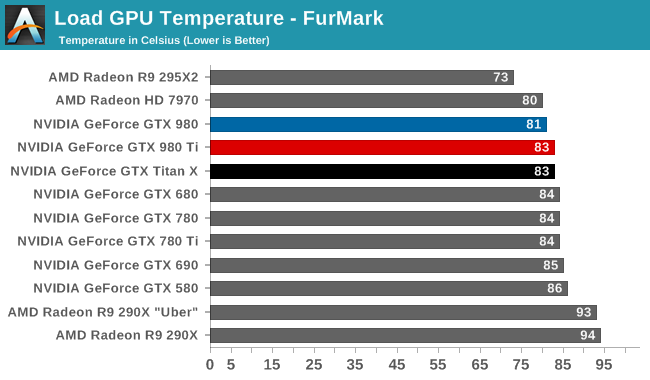
As was the case with power consumption, video card temperatures are similarly unchanged. NVIDIA’s metal cooler does a great job here, keeping temperatures low at idle while NVIDIA’s GPU Boost mechanism keeps temperatures from exceeding 83C under full load.
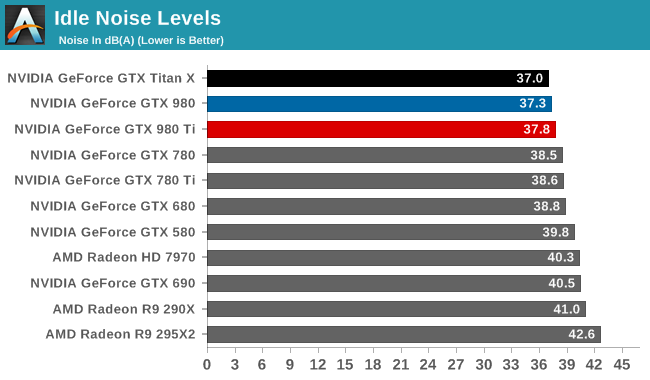
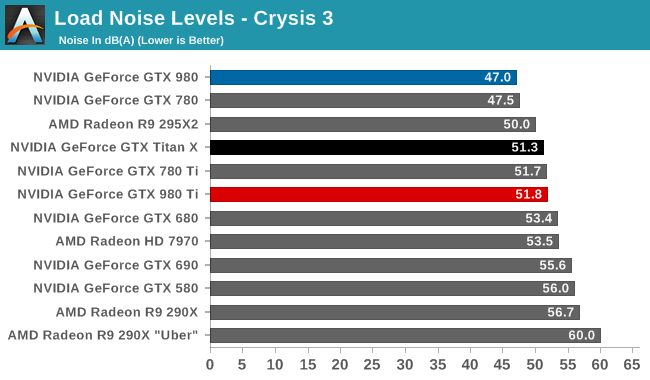
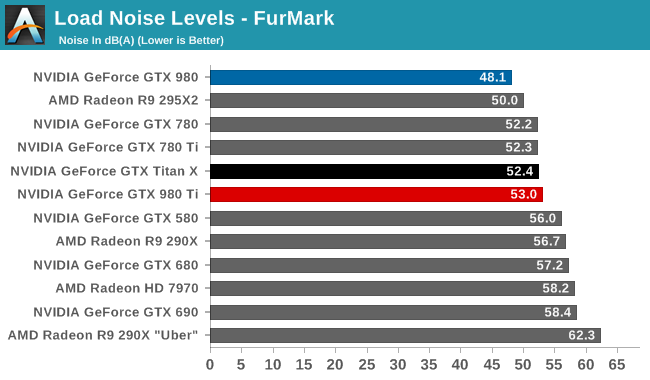
Finally for noise, the situation is much the same. Unexpected but not all that surprising, the GTX 980 Ti ends up doing a hair worse than the GTX Titan X here. NVIDIA has not changed the fan curves or TDP, so this ultimately comes down to manufacturing variability in NVIDIA’s metal cooler, with our GTX 980 Ti faring ever so slightly worse than the Titan. Which is to say that it's still right at the sweet spot for noise versus power consumption, dissipating 250W at no more than 53dB, and once again proving the mettle of NVIDIA's metal cooler.










290 Comments
View All Comments
Daroller - Monday, June 1, 2015 - link
Likely true, and it's really a sad situation for AMD... which is a bad situation for PC gaming in general. AMD desperately needed NV to price this card $150 - $200 higher.xthetenth - Monday, June 1, 2015 - link
Look at the reviews of the 980 Hybrid that just came out. A watercooled version is a very good thing even on a less than 300W card. A watercooled Fiji is going to be putting out way less heat than a 295X even if it's overclocked, and compare the 295X temp and noise to an OC 980 Ti. Using a much better cooler that should allow some great OC performance is not a guarantee of weakness.andychow - Monday, June 1, 2015 - link
"preemptive" seems like a strong word. AMD was supposed to release the 3XX series in February, then March. Then it was "comming soon". We're in June, it's still not out. And AMD makes a silly youtube video "It's Coming", then Nvidia releases the 980 Ti before them!AMD drops the ball, again.
FlushedBubblyJock - Wednesday, June 10, 2015 - link
Now that's funny - all those nvidia strategist posters .... their pants have fallen below the ankles and over and off their feet.StealthGhost - Sunday, May 31, 2015 - link
Any reason why the GTX 970 is being left out of the charts and bench GPU 2015?Ryan Smith - Sunday, May 31, 2015 - link
Bench results are compiled as we test cards for articles. We've had no need to test GTX 970 for any articles yet this year, so its results are not yet in Bench '15.takeship - Monday, June 1, 2015 - link
970 performance can be inferred from the charts anyways. Step one: look at 980 perf, step two: subtract 10~15%. Method valid up to 1440p, above that 970 chokes on the VRAM requirements. Alternatively, take 290 perf, and add 10~20%, depending on whether the game is TWIMTBP or not.octiceps - Sunday, May 31, 2015 - link
The larger-than-expected gap in pixel fillrate suggests that 980 Ti has a partially disabled ROP/MC partition and segmented memory just like 970. Could AT please investigate this?I don't care what GPU-Z says right now. It was wrong about 970 at first and it could be wrong now.
Ryan Smith - Sunday, May 31, 2015 - link
Yep. We've checked."Just to be sure we checked to make sure the ROP/MC configuration of GTX 980 Ti was unchanged at 96 ROPs"
None of the ROP/MC partitions have been disabled, and all 3MB of L2 cache is available.
octiceps - Monday, June 1, 2015 - link
Did you check with CUDA deviceQuery and Nai's Benchmark?